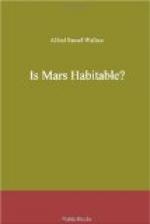Several baked clay balls might be formed to serve as cores, say of 8 to 10 inches in diameter. These being fixed within moulds of say half an inch to an inch greater diameter, the outer layer would be formed by pouring in some suitable heated liquid material, and releasing it from the mould as soon as consolidation occurs, so that it may cool rapidly from the outside. Some kinds of impure glass, or the brittle metals bismuth or antimony or alloys of these might be used, in order to see what form the resulting fractures would take. It would be well to have several duplicates of each ball, and, as soon as tension through contraction manifests itself, to try the effect of firing very small charges of small shot to ascertain whether such impacts would start radiating fractures. When taken from the moulds, the balls should be suspended in a slight current of air, and kept rotating, to reproduce the planetary condition as nearly as possible.
The exact size and material of the cores, the thickness of the heated outer crust, the material best suited to show fracture by contraction, and the details of their treatment, might be modified in various ways as suggested by the results first obtained. Such a series of experiments would probably throw further light on the physical conditions which have produced the gigantic system of fissures or channels we see upon the surface of Mars, though it would not, of course, prove that such conditions actually existed there. In such a speculative matter we can only be guided by probabilities, based upon whatever evidence is available.
CHAPTER VIII.
SUMMARY AND CONCLUSION.
This little volume has necessarily touched upon a great variety of subjects, in order to deal in a tolerably complete manner with the very extraordinary theories by which Mr. Lowell attempts to explain the unique features of the surface of the planet, which, by long-continued study, he has almost made his own. It may therefore be well to sum up the main points of the arguments against his view, introducing a few other facts and considerations which greatly strengthen my argument.
The one great feature of Mars which led Mr. Lowell to adopt the view of its being inhabited by a race of highly intelligent beings, and, with ever-increasing discovery to uphold this theory to the present time, is undoubtedly that of the so-called ’canals’—their straightness, their enormous length, their great abundance, and their extension over the planet’s whole surface from one polar snow-cap to the other. The very immensity of this system, and its constant growth and extension during fifteen years of persistent observation, have so completely taken possession of his mind, that, after a very hasty glance at analogous facts and possibilities, he has declared them to be ’non-natural’— therefore to be works of art—therefore to necessitate




